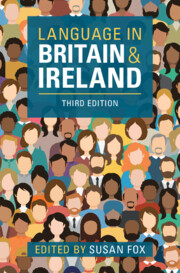Book contents
- Language in Britain and Ireland
- Language in Britain and Ireland
- Copyright page
- Contents
- Figures
- Tables
- Contributors
- Acknowledgements
- Map of Britain and Ireland
- Introduction
- Part I English
- Part II Multilingualism in Britain and Ireland: The Celtic Languages
- Part III Multilingualism in Britain and Ireland: Minority Languages
- Part IV Multilingualism: The Development of Urban Contact Varieties
- 21 Multicultural London English
- 22 British Asian English
- 23 Multicultural British English
- Part V Applied Sociolinguistic Issues
- Index
- References
21 - Multicultural London English
from Part IV - Multilingualism: The Development of Urban Contact Varieties
Published online by Cambridge University Press: 17 October 2024
- Language in Britain and Ireland
- Language in Britain and Ireland
- Copyright page
- Contents
- Figures
- Tables
- Contributors
- Acknowledgements
- Map of Britain and Ireland
- Introduction
- Part I English
- Part II Multilingualism in Britain and Ireland: The Celtic Languages
- Part III Multilingualism in Britain and Ireland: Minority Languages
- Part IV Multilingualism: The Development of Urban Contact Varieties
- 21 Multicultural London English
- 22 British Asian English
- 23 Multicultural British English
- Part V Applied Sociolinguistic Issues
- Index
- References
Summary
This chapter presents an overview of Multicultural London English (MLE), the urban contact vernacular that has emerged in London in recent years. It starts with a discussion of how similar varieties have been reported across other European cities and have become known as multiethnolects, meaning that they are not restricted to any particular ethnic group but are available to anyone, including speakers from non-immigrant backgrounds. The chapter then focuses on the specific social and historical circumstances that have led to the emergence of MLE, from its beginnings in the 1980s to the present day. After presenting the linguistic characteristics of MLE, a discussion follows of the ways in which MLE has been perceived in the media and by users and non-users of MLE, and how attitudes towards the variety may influence its trajectory in the future. While there is some suggestion that the variety (or some variation thereof) may not be restricted to London, it is not clear whether MLE will stabilise to an everyday vernacular spoken in inner-city neighbourhoods and beyond or whether it will divide along social and ethnic lines. The chapter concludes with a discussion of new research being undertaken to answer some of these issues.
Keywords
- Type
- Chapter
- Information
- Language in Britain and Ireland , pp. 455 - 470Publisher: Cambridge University PressPrint publication year: 2024

